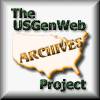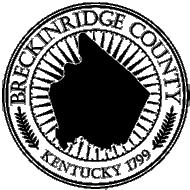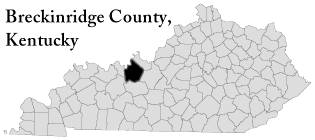 |
USGenWeb Archives Project Breckinridge County, Kentucky |
 |
 |
 |
 |
 |
USGenWeb Archives Project Breckinridge County, Kentucky |
 |
 |
 |
 |
THESE
ARCHIVES BUILT BY YOUR
CONTRIBUTIONS.
PLEASE CONTRIBUTE TODAY!
New
Easy to use Submission
Forms!
This Page Updated Monday, 11-Apr-2022 20:27:45 EDT
| BRECKINRIDGE COUNTY, KENTUCKY |
| AREA COMMUNTIES OF THE PAST AND PRESENT |
| HARDINSBURG |
Hardinsburg is a typical little county seat town. Like many
of the others in our state, it was the first settlement in the
county and is centrally located. It
is approximately 35
miles across the county either north to South or East to West.
The county
seat towns were usually centrally located in order that the most
remote sections would be able to travel to and from the
courthouse in one day.
Those of us who are
old enough remember know that thirty
miles in a wagon, over mud roads, is a good day’s travel.
The first courthouse was made of logs and erected in 1801. In
1868, the old courthouse was replaced by a new one.
This one was built
of brick which were burned on Mr.
Hook’s farm. The
brick kiln was located in the
schoolhouse yard between
the school building and Mr. Sherman Beauchamp’s home. Mr.
Edgar Bennett of Basin Springs erected the building.
This
new
courthouse was a thing of pride to the people of Breckinridge
County. It was of
red brick with a large dome on the top.
Many a country
boy, on his first trip to the county seat, looked with amazement
at this gigantic structure. The
building stood the storms
of time and answered
well its purpose until it went up in flames February 7, 1958.
The fire broke out in the extreme upper part of the
building so
all hands and the
cook put forth every effort and succeeded in carrying to safety
all of the early and valuable records of the county.
Immediately, the people of the county set themselves to
the task
of building a new courthouse. This
structure, modern and
beautiful, stands today as a symbol to the courage and
progressive spirit of our people.
The Hook family is one of the oldest families that are
still
connected with the business life of Hardinsburg.
Mr.
Russell Hook,
Mathias Hook and Howard Hook, are the sons of Mr. Jeff Hook, who
in early life operated a sawmill and a flour mill in Hardinsburg.
In 1913,
he went into the automobile business.
He owned and operated
the Ford garage and owned the first car in the county.
Mr.
Jeff Hook
was a familiar figure around Hardinsburg most of his life. He
contributed much to the success of several business enterprises,
holding the respect
and esteem of all who knew him.
Jeff Hook was one of twenty-one children born to George
Hook.
Mr. George, in addition to being very prolific, was a
well-respected citizen of the Hardinsburg district.
His
home was two miles southwest of Hardinsburg, on the little
Owensboro road. George
Hook was the son of John and Lucretia (Wood) Hook, and the
grandson of John Hook who was a soldier in George
Washington’s army during the
Revolutionary War. Mr.
John Hook was a native of
Pennsylvania. In
1818, John the II moved to Breckinridge
County. Mr. George
Hook was born here in 1825.
The Hook family has always been mechanically inclined. They
loved engines, saw mills, and flour mills.
Mr. Jubal Hook, who was a brother to George Hook and
father of
Clint, Bud and Charley, operated a grain mill on the corner where
the
Gulf oil station now stands. Mr.
Hook had an old colored
man who ran the steam engine, his name was Boaz Poole.
Boaz
had a desire to ride
the fly wheel on the engine. One
day he tied a string to
the throttle of the engine, then seated himself on the hub of the
fly wheel. His head
was braced against the other side of the rim.
He then
pulled the string and held onto the spokes.
He pulled the
string a little too hard giving the
engine more steam than he had intended and his act had begun.
Fortunately, Mr. Hook came in a few minutes later and
stopped the
engine.
Boaz fell off on
the ground pretty well shaken up, but
satisfied.
Howard, Mathias, and Russell Hook are all business men of
present
day Hardinsburg.
Mathias Hook is in the road building business and operates
a lot
of heavy equipment. He
also has a Ready Mix concrete plant
in
Hardinsburg and sometimes carried as many as 100 men on his
payroll.
The Hook brothers sold their garage several years ago to a
Mr. J.
C. Blancett from Calhoun, Kentucky, who has carried on quite a
successful
business.
Mr. Russell Hook might be best classified as a student of
history. He was one
of the fortunate ones, and through good
business practices
he was able to retire at age 21. Since
then he has spent a
portion of every day studying history.
He says he spends
his time learning history.
When he was in
school he had to study it; and he
didn’t like it then. He
is a member of the Kentucky
Historical Society, the Civil War Society
of Kentucky, the Filson Club, and the McCoy Roundtable.
The McCoy Roundtable is so called because it is held in
Hershel
McCoy’s restaurant, where may be had the best coffee in the
nation.
This organization has no dues, no by-laws, no fees and no
particular purpose but it is the breeding ground for political
movements,
Civic advancement, Historical research and the uncovering of
forgotten Folklore.
This Roundtable is composed of some ten or twelve members
who
meet regularly every day and discuss such subjects as might come
into the
minds of the first members present.
These gentlemen are all
very scholarly; and with very few exceptions their discussions
are quite enlightening. Occasionally
these discussions
become accelerated to the point of being categorized as
arguments.
This McCoy Roundtable consists of Russell Hook, Jim Ames,
Hughes
Goodman, Paul Fuqua, Ed Robbins, Sam Fuqua, Wade Glasscock
and others. This
group meets every day with a very high
percentage of attendance.
The discussions at this McCoy Roundtable have much in
common with
the type of arguments that took place in the ancient Athenian
court yards
some two to four hundred years before Christ.
This type gathering, where each person present divulges
his
personal philosophic view of current problems, is a thing common
to most all rural
county seat towns; but seemingly has escaped the credit for which
it is due. Mr.
Samuel Johnson, the Medieval English author,
once said that the great
majority of the progress of civilization has its origin in a
tavern.
Mr. Russell Hook who is generally the leading spokesman
for the
Roundtable is financially able to travel extensively but he finds
Hardinsburg to
be the most fascinating place on the globe.
On one occasion
he went to Florida to spend a month vacation; but after a few
days there he could stand it
no longer so he hurried home to get his books and learn about the
places he had been and seen. Mr.
Russell and his books are
as interwoven as Socrates
and his circles.
In 1840, a route was established from Hardinsburg to
Leitchfield.
The first Rural Route established out of the Hardinsburg
office
was in 1908. It ran
a distance of 24.75 miles and served
thirty-seven
families. Since
that time, with the improvement of roads
and transportation, mail is delivered to practically every door
in the county every day.
Soon after 1908, these rural routes were established and
mail was
delivered all over the county. These
early rural carriers
deserve a
place of praise in American history.
Their faithfulness and
the sense of duty and responsibility under the worst sort of
environmental circumstances put them
in the category with the country doctors of that same seemingly
impossible age.
Mr. Jim Noblett, the father of Colman Noblett, who lives
at
Harned, was one of these rural carriers.
In the winter of
1917 and 1918, when
the big snow fell and stayed on the ground all winter, Mr.
Noblett was carrying the mail from Harned to Roff.
He
usually rode a horse, but the snow was so
deep and covered with a deep layer of ice that he was forced to
abandon his horse and travel on foot.
One morning he
wobbled into Mr. Frankie Mattingly’s
store and post office at Roff carrying his bulging mail pouch and
the temperature was ten below zero.
He delivered his burden
to the postmaster, then went
behind the old pot-bellied stove and thawed out.
Finally he
made ready for his return trek to Harned, but as he went to the
door he said, “Gentlemen, you may
hear of wars and rumors of wars but you will never hear of Jim
Noblett bidding on another mail route.”
The old city hall was owned by Mr. Green Beard and stood
across
the street from Dr. Sills’ Medical Center.
From the Civil War until World War I this old city hall
was a
place for business and political meetings as well as a place of
amusement. There
were many medicine shows held there.
These medicine shows often stayed as long as a week at a
time.
They had their comedians and other type entertainers that
could
draw a crowd,
then acted as salesmen between acts.
One such show was, Dr. Emmerson’s Health Giver. It was
probably stump-water but it cured many an ailment.
In 1910, Mr. Bud sills put a picture show in the old city
hall.
It was powered by a gasoline engine that pulled a
generator.
This was Dr.
Sills’ grandfather. These
were silent pictures but Mr.
Sills supplied his own music. His
brother, Jonas sills,
played a piano and beat a drum, or furnished
about any other type music necessary for the occasion.
Most
of these old silent pictures were serials, and you just had to go
back week after week to see how
the show turned out.
About 1920, The Knights of Columbus put up the building
where the
Leanheart’s Variety and Storms’ appliance store is.
The McGary brothers rented the building and put in a real
picture
show that talked. This
furnished amusement and recreation
for a number of
years until drive-in theaters and television put them on the
blink.